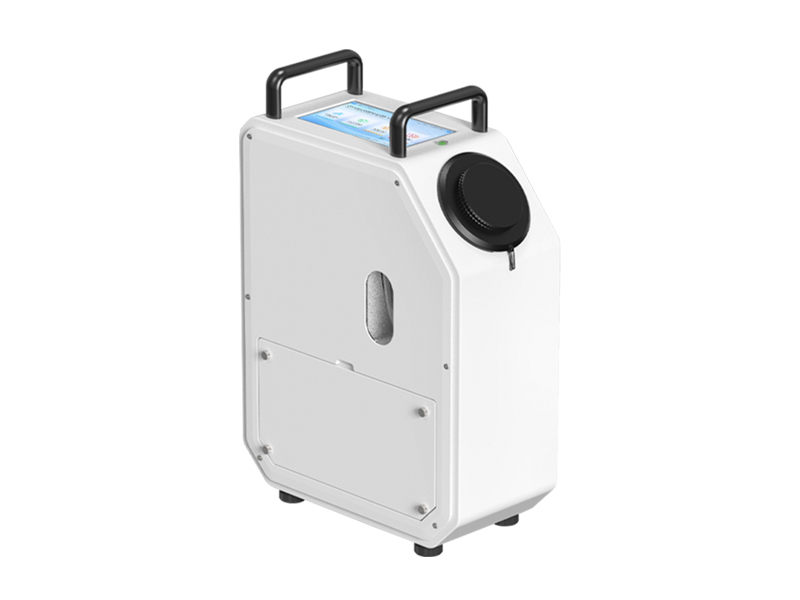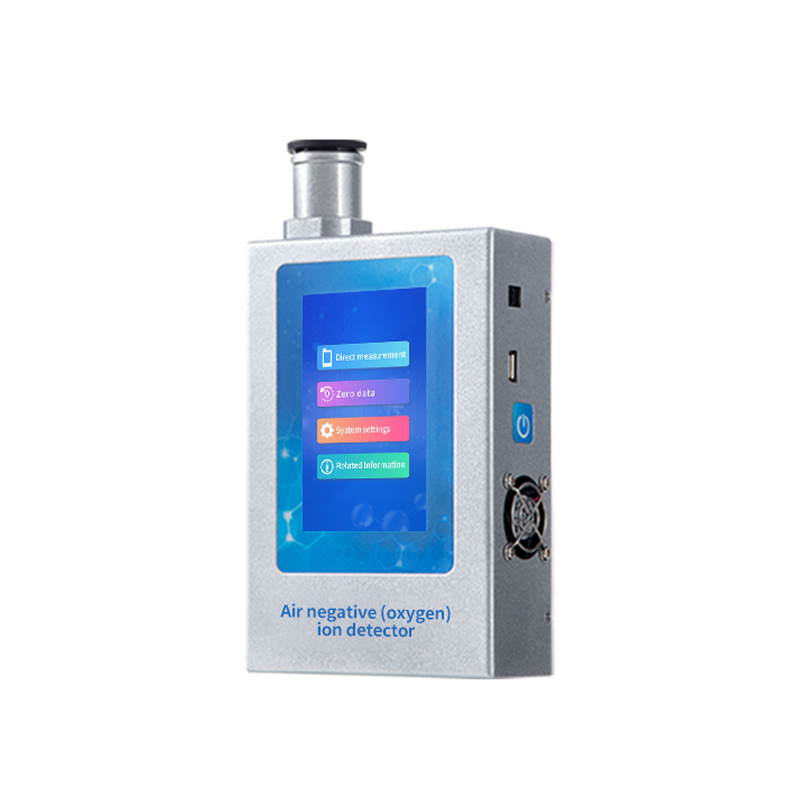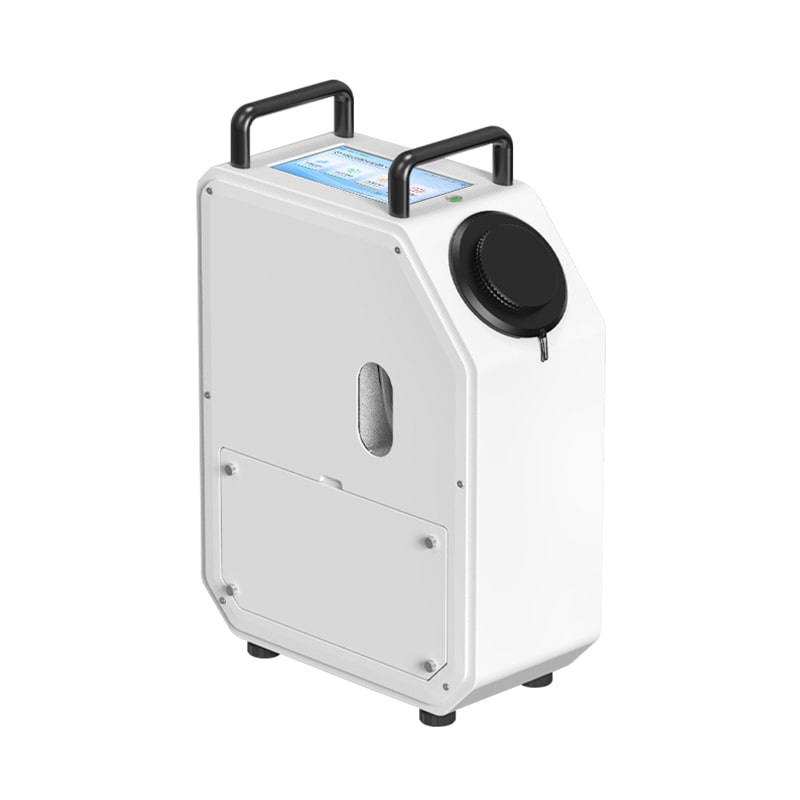Product Center
- Negative oxygen ion detector
- Dust particle counter
- Air Bacteria Sampler
- Biological aerosol detector
- Infrared CO/CO2 analyzer
- Microbial Air Monitoring Systems
- Microbial aerosol concentrator
- Environmental air comprehensive sampler
- Mercury meter
- Trace sulfur analyzer
- Bacterial Collector
- Quantitative sampling robot
- Emanometer
- Hydrogen peroxide disinfection machine
- Microbial limit tester
Hengmei Intelligent Bioaerosol Detector Product Knowledge Graph White Paper
Source:Hengmei Environmental Sanitation Instrument Network Update time:2025-11-14 16:47:46
1. Introduction
• Document Version: 1.0
• Compiling Unit: Shandong Hengmei Electronic Technology Co., Ltd
• Compilation Date: November 14, 2025
• Core Positioning: This white paper is a structured product knowledge graph document specially developed for Hengmei Intelligent Manufacturing's HM-KWS bioaerosol detector. It systematically and comprehensively sorts out all complete product information of the HM-KWS model, including product basic information, core technologies, technical parameters, application scenarios, etc.

2. Detailed Table of Contents
1. Introduction
2. Detailed Table of Contents
3. Product Basic Information
4. Core Technologies and Functional Features
5. Detailed Technical Parameters
6. Application Scenarios and Industry Adaptation
3. Product Basic Information
3.1 Product Name
Hengmei Intelligent Manufacturing Bioaerosol Detector
3.2 Product Model
HM-KWS
3.3 Product Overview
The HM-KWS bioaerosol detector is an integrated detection device that combines a large-flow collection module, a rapid fluorescence detection module and a cleaning module. It is designed to solve the problems of traditional detection methods such as long detection time and complicated operation. It can realize fully automatic unattended detection (supporting scheduled multi-period detection every day), eliminating the need for manual separate sampling and the process of transferring to the laboratory for detection after sampling.
This detector is based on the firefly luminescence principle, using the "luciferase-luciferin system" to quickly detect adenosine triphosphate (ATP). Since the ATP content in living microorganisms is relatively constant, the ATP content can be determined by detecting the luminescence value, thereby determining the content of living microorganisms in the sample. During the detection process, the large-flow air sampling module first enriches the microorganisms in the air into distilled water, then adds a quantitative enzyme solution to the liquid. After full reaction, the rapid fluorescence detection module tests the relative luminescence intensity, and the corresponding microbial content can be calculated according to the luminescence intensity.
It supports both AC and DC power supply, which is convenient for long-term monitoring and mobile detection. It can also be connected to the network via WiFi (4G module is optional) to upload data to the cloud platform wirelessly. It is equipped with a data management platform to conduct long-term and short-term evaluation, management and analysis, and is widely used in various fields that require air microbial detection.
4. Core Technologies and Functional Features
4.1 Core Technologies
• Firefly Luminescence Principle-based ATP Detection Technology: This technology uses the specific reaction between luciferase and luciferin with ATP. Since ATP is a unique energy substance in living organisms and its content in living microorganisms is relatively constant, the luminescence value generated by the reaction is detected to invert the ATP content, and then the content of living microorganisms in the sample is determined. This technology skips the traditional microbial culture process, greatly shortening the detection time.
• Dry Wall Cyclone Gas-Solid Separation Technology: Applied in the large-flow air sampling module of the instrument, it can efficiently separate and enrich the microbial particles in the air into the lysate (distilled water). The collection efficiency is as high as 92%, which ensures the sufficient collection of microorganisms and lays a foundation for accurate detection.
• PMT Photomultiplier Tube Detection Technology: The detector adopts a PMT (Photomultiplier Tube) photomultiplier tube detector, which has high sensitivity to weak fluorescence signals. It can accurately capture the weak luminescence generated by the ATP-luciferase reaction, improve the detection accuracy of the instrument, and reduce the detection limit (the ATP detection limit can reach 10⁻¹⁰ to 10⁻¹⁸ mol ATP).
• Android Operating System Platform Technology: The instrument is equipped with the Android 7.1 operating system, with 2G RAM and 16G ROM. It has good compatibility and storage capacity, supporting the operation of various functional software (such as data management software, scheduled detection control software). The touch screen operation is convenient and fast, and it can realize human-computer interaction intuitively.
• Dual Power Supply Technology (AC and DC): The instrument supports 12V DC power supply (equipped with a 12V/10000mAh battery) and can also be powered by an AC power supply (matching a 12V/3A charger). This dual power supply mode makes the instrument suitable for both fixed long-term monitoring (using AC power) and mobile on-site detection (using battery power), improving the flexibility of use.
4.2 Functional Features
• Integrated Full-Automatic Detection: It integrates a large-flow collection module, a rapid fluorescence detection module and a cleaning module. It can complete the whole process of air sampling, microbial enrichment, reagent addition, reaction detection and automatic cleaning without manual intervention, realizing unattended operation.
• Scheduled Multi-Period Detection: The instrument supports setting multiple detection periods every day (the specific number can be set according to user needs). It can automatically start detection at the preset time, which is suitable for long-term continuous monitoring scenarios (such as environmental monitoring in clean workshops, public places, etc.).
• Rapid Detection and Automatic Data Reporting: The detection time can be adjusted between 2-180 seconds, and the detection results can be automatically calculated and reported after the detection is completed. The detection range covers 0-9999999 RLUs (Relative Luminescence Units), which can meet the detection needs of different microbial concentration levels.
• Wireless Data Transmission and Cloud Platform Connection: It supports WiFi network connection, and can upload the detected data to the cloud platform wirelessly. A 4G module can be optionally configured to realize data transmission in areas without WiFi coverage, ensuring the real-time and remote sharing of data.
• Data Management and Analysis: It is equipped with a dedicated data management platform, which can store, query, export and analyze the detected data (including long-term and short-term data evaluation). Users can view historical data, generate data reports and analyze data trends through the platform, providing a basis for decision-making.
• GPS Positioning Function (Optional): A positioning module can be optionally configured to record the geographic location information of the detection site while detecting. This function is especially suitable for mobile detection scenarios (such as on-site detection of biological emergency incidents), which is convenient for tracing the detection location and managing detection points.
• Lightweight and Portable Design: The instrument weighs 8KG, with an overall size of 337163480mm, and the packaging size is 550245375mm (packaging weight 10.5KG). It is small in size and light in weight, easy to carry and transport, and convenient for on-site detection in different locations.
• Automatic Cleaning Function: After the detection is completed, the instrument can automatically clean the sampling pipeline and detection module to avoid cross-contamination between different samples and ensure the accuracy of subsequent detection results.
5. Detailed Technical Parameters
5.1 System Parameters
• Operating System: Android 7.1
• Memory Configuration: RAM 2G, ROM 16G
• Display and Operation: Equipped with a 7-inch color touch screen (consistent with the mainstream Android device operation logic, supporting touch control)
5.2 Air Sampling Parameters
• Air Sampling Flow Rate: 245 L/min (stable flow rate, ensuring efficient sampling)
• Adjustable Sampling Volume Range: 10-750 L (users can set the sampling volume according to the detection environment and requirements)
• Collection Efficiency: 92% (based on dry wall cyclone gas-solid separation technology, ensuring efficient enrichment of microorganisms)
5.3 Detection Performance Parameters
• Detection Time: Adjustable within 2-180 seconds (short detection time, improving detection efficiency)
• Detection Range: 0-9999999 RLUs (Relative Luminescence Units, covering low to high microbial concentration detection)
• ATP Detection Limit: 10⁻¹⁰ to 10⁻¹⁸ mol ATP (high detection sensitivity, capable of detecting trace microorganisms)
• Detector Type: PMT (Photomultiplier Tube) photomultiplier tube detector (high sensitivity to weak fluorescence signals)
5.4 Environmental Adaptation Parameters
• Operating Temperature Range: 18-45 ℃ (suitable for most indoor and outdoor detection environments)
• Relative Humidity Adaptability: ≤ 90% (normal operation under high humidity environment, no condensation required)
• Anti-Interference Performance: Resistant to non-corrosive gas interference, no strong electromagnetic field and strong vibration environment (to ensure stable operation of the instrument)
5.5 Power Supply and Battery Parameters
• Power Supply Mode: Dual power supply (AC and DC)
◦ AC Power Supply: Matched with 12V/3A charger (input AC 220V ±10%, 50Hz)
◦ DC Power Supply: Built-in 12V/10000mAh battery (rechargeable lithium battery)
• Stand-by Time: ≥ 10 hours (under battery power supply, meeting the needs of long-term mobile detection)
• Average Power Consumption: 6W (low power consumption, prolonging battery life during mobile use)
5.6 Physical Specifications
• Instrument Size (Length × Width × Height): 337 × 163 × 480 mm (compact size, easy to place and carry)
• Instrument Weight: 8 KG (lightweight, convenient for manual transportation)
• Packaging Size (Length × Width × Height): 550 × 245 × 375 mm (packaging size suitable for logistics transportation)
• Packaging Weight: 10.5 KG (including instrument, accessories and packaging materials)
6. Application Scenarios and Industry Adaptation
6.1 Application Scenarios
• On-Site Rapid Detection of Biological Emergency Incidents: In the event of biological emergency incidents (such as sudden outbreaks of infectious diseases, suspected biological toxin pollution, etc.), the instrument can be quickly transported to the incident site. With its mobile detection capability (battery power supply) and rapid detection function (detection time 2-180s), it can quickly sample and detect the air microorganisms at the site, providing real-time data support for emergency disposal decisions.
• Disease Prevention and Control Field: It is used in disease prevention and control institutions to detect the air microbial content in key places such as hospitals (ward, operating room), centralized isolation points, and public transportation hubs (railway stations, airports). It helps to monitor the spread risk of airborne pathogens, evaluate the effect of disinfection and sterilization, and prevent the spread of infectious diseases.
• Environmental Protection Field: It is applied to the detection of air microorganisms in environmental monitoring points (such as urban parks, industrial areas, sewage treatment plants). It can monitor the changes of air microbial diversity and concentration in the environment, evaluate the impact of human activities (such as industrial production, domestic waste treatment) on the air microbial environment, and provide data for environmental quality assessment.
• Pharmaceutical Industry: Used in the clean workshops (such as pharmaceutical production workshops, laboratory biosafety cabinets) of pharmaceutical enterprises. It can monitor the air planktonic bacteria content in the clean area in real time, ensure that the microbial index of the production environment meets the GMP (Good Manufacturing Practice) standards, and avoid microbial pollution affecting the quality of pharmaceutical products.
• Fermentation Industry: In the fermentation production process of enterprises (such as beer fermentation, microbial fertilizer production), the instrument can detect the air microorganisms in the fermentation workshop. It helps to monitor the occurrence of miscellaneous bacteria pollution in the workshop, ensure the normal progress of the fermentation process, and improve the yield and quality of fermentation products.
• Food Industry: Applied to the air microbial detection in food processing plants (such as meat processing, dairy product production), food storage warehouses and catering places. It can monitor the microbial pollution risk in the food production and sales links, prevent food from being contaminated by airborne microorganisms and causing food safety accidents.
• Biological Clean Field: Used in biological clean rooms (such as semiconductor manufacturing clean rooms, biological laboratory clean areas) to detect the air microbial content. It ensures that the microbial concentration in the clean environment meets the specified standards, and provides a clean environment for the production and research of precision products.
• Public Places: It is used in public places with large people flow, such as shopping malls, cinemas, schools and office buildings. It can regularly detect the air microbial content, evaluate the air quality of public places, and provide a basis for formulating ventilation and disinfection measures to protect the health of the public.
• Teaching and Scientific Research Institutions: It is used in colleges and universities, scientific research institutions (such as life science colleges, environmental science research institutes) for teaching and scientific research experiments. It can be used for the research on air microbial ecology, the development of microbial detection methods and the verification of new detection technologies, providing a practical tool for teaching and scientific research.
6.2 Industry Adaptation
• Disease Prevention and Control Industry: Disease prevention and control centers at all levels, infectious disease hospitals and other units use the instrument to carry out air microbial monitoring work, which is an important tool for preventing and controlling the spread of airborne infectious diseases.
• Environmental Protection Industry: Environmental monitoring stations, environmental protection technology companies and other units apply the instrument to environmental air quality monitoring projects, especially in the field of microbial pollution monitoring, which enriches the indicators of environmental quality assessment.
• Pharmaceutical Industry: Pharmaceutical manufacturers (including chemical pharmaceuticals, biological pharmaceuticals, traditional Chinese medicine manufacturers) and pharmaceutical supervision and inspection institutions use the instrument to monitor the microbial indicators of the clean production environment, ensuring that pharmaceutical products meet the quality standards.
• Fermentation Industry: Fermentation product manufacturers (such as beer, wine, soy sauce, microbial fertilizer manufacturers) use the instrument to monitor the air environment of the production workshop, prevent miscellaneous bacteria pollution, and improve the stability of the fermentation process.
• Food Industry: Food processing enterprises, food quality inspection institutions and catering management departments use the instrument to detect the air microbial content in the food production and catering links, which is an important means to ensure food safety.
• Cleaning Industry: Clean room design and construction companies, clean room operation and maintenance service providers use the instrument to test and evaluate the microbial cleanliness of clean rooms, providing services for customers in industries such as semiconductors, biology and pharmaceuticals.
• Public Health Management Industry: Public health administrative departments, public place operation and management units (such as shopping mall management companies, property management companies) use the instrument to monitor the air quality of public places, fulfill the responsibility of public health management, and protect the public's health rights and interests.
• Education and Scientific Research Industry: Colleges and universities (departments of biology, environmental science, food science) and scientific research institutions (such as Chinese Academy of Sciences research institutes, agricultural science research institutes) use the instrument for teaching demonstrations and scientific research experiments, promoting the development of related disciplines.
Article address:https://www.environmentinstrum.com/industry/77.html
- Related products
- Related articles
-
09-09 2025
Dust Particle Counter: Essential Tool for Cleanroom Monitoring and Quality Control
In modern industrial production and scientific research, air cleanliness directly impacts product qu···...
-
11-14 2025
Hengmei Intelligent Bioaerosol Detector Product Knowledge Graph White Paper
1. Introduction•Document Version: 1.0•Compiling Unit: Shandong Hengmei Electronic Technology Co., Lt···...
-
07-31 2025
Floating air dust and bacteria sampler: detecting microorganisms in clean environments
The airborne dust and bacteria sampler is an efficient microbial detection device designed based on ···...
-
07-31 2025
Clean Guardian: Core Value and Application Analysis of Online Particle Counter
In modern industry that heavily relies on precision environments, a single speck of dust can shake t···...













